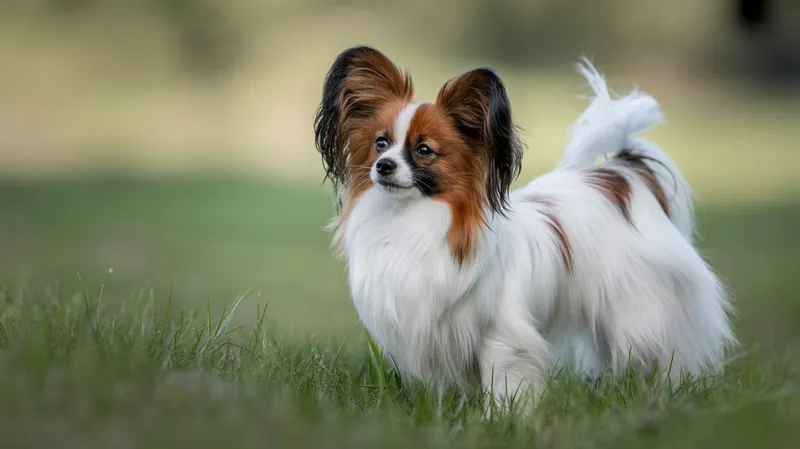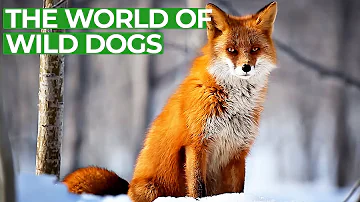
Papillon Dog
Canis lupus familiaris

Meet the Papillon Dog
The Papillon is a small, elegant toy dog breed known for its distinctive butterfly-like ears, from which its French name 'Papillon' (meaning 'butterfly') is derived. Highly intelligent and energetic, Papillons are renowned for their agility, quick learning, and sociable nature. Their fine, flowing coat is typically white with patches of color, and they are often seen excelling in dog sports and obedience competitions. Despite their delicate appearance, Papillons are robust and adaptable, making them excellent companions for a variety of households.
Classification
Mammal
Habitat
Domestic
Diet
Omnivore
Lifespan
12-16 years
Conservation
Not Evaluated (Domestic Breed)
Weight
3-5 kg (6.6-11 lbs)
📖Fascinating Facts
Butterfly Ears
The Papillon’s large, fringed ears resemble butterfly wings, giving the breed its unique name.
Agility Stars
Papillons are consistently among the top performers in dog agility and obedience competitions worldwide.
Royal Companions
Papillons were favored by European nobility and can be seen depicted in Renaissance paintings alongside their aristocratic owners.
📋Detailed Description
The Papillon is a diminutive yet robust toy breed, typically weighing between 3.6 to 4.5 kg (8–10 lbs) and standing 20–28 cm (8–11 inches) at the withers. Its most defining feature is its large, fringed, upright ears, which resemble the wings of a butterfly, though a drop-eared variety known as the Phalène also exists. The breed has a fine-boned, graceful build, with a slightly elongated body and a plumed tail that arches over the back. Papillons possess a single, silky coat that is predominantly white with patches of color, most commonly sable, black, or red. Their expressive, dark, almond-shaped eyes contribute to their alert and lively demeanor. Highly intelligent and trainable, Papillons excel in obedience, agility, and canine sports, often outperforming larger breeds. They are known for their curiosity, adaptability, and strong attachment to their human companions. Despite their small size, Papillons are active and require regular mental and physical stimulation. Their lifespan is notably long for a dog, averaging 12–16 years, with some individuals reaching 17 years or more. The breed is generally healthy, though patellar luxation and dental issues can occur due to their size.
💡 Did you know?
Despite their small size, Papillons are highly athletic and can often be seen winning at canine sports competitions against much larger breeds.
🔬Research & Sources
🎭Behavior & Social Structure
Papillons are highly social and thrive on human interaction, forming strong bonds with their families and often displaying a preference for being involved in household activities. They are alert and vocal, making them effective watchdogs despite their size. Their intelligence and eagerness to please make them responsive to training, and they often learn new commands rapidly. Papillons are playful and energetic, requiring daily exercise such as walks, play sessions, or agility training to prevent boredom and associated behavioral problems. They are not prone to aggressive behaviors but may exhibit reserved tendencies toward strangers if not properly socialized. Feeding behavior is typical of small companion breeds; they do best on a balanced, high-quality diet and may be prone to selective eating. Socially, Papillons can coexist well with other dogs and pets if introduced appropriately, though their small size necessitates supervision around larger animals and young children.
👶Reproduction & Life Cycle
Papillons reach sexual maturity between 6–9 months, though responsible breeding is recommended after 18 months of age. The breed exhibits typical canine mating behaviors, with estrus cycles occurring approximately every six months in females. Gestation lasts about 63 days, and litter sizes range from 2 to 4 puppies, though litters of up to 6 are possible. Papillon mothers are attentive, providing extensive care, warmth, and grooming to their offspring during the first few weeks. Puppies are born blind and deaf, opening their eyes at around 10–14 days. Weaning begins at 4–5 weeks, and puppies are generally ready for adoption at 10–12 weeks, after socialization and basic training. There is no defined breeding season, as domestic dogs can reproduce year-round, but ethical breeders limit frequency to maintain maternal health.
🛡️Adaptations & Survival
Papillons have evolved several adaptations suited to their role as companion animals. Their small size and lightweight frame facilitate agility and speed, making them adept at navigating complex environments and excelling in canine sports. The large, mobile ears enhance auditory acuity, allowing them to detect subtle sounds and respond quickly to environmental cues. Their expressive faces and social intelligence are products of domestication, enabling nuanced communication with humans. The breed's long, single-layer coat provides moderate protection without excessive bulk, suitable for indoor living. Behavioral adaptations include high trainability, sociability, and a strong desire for human companionship, all of which have been reinforced through selective breeding for temperament and appearance.
📚Research Sources
🎨Cultural Significance
The Papillon has a distinguished history as a companion to European nobility, particularly in France, Italy, and Spain, dating back to at least the 16th century. The breed is frequently depicted in Renaissance and Baroque art, including works by Titian, Rubens, and Watteau, symbolizing elegance, refinement, and loyalty. Papillons were favored by royalty such as Marie Antoinette and Madame de Pompadour, contributing to their status as a symbol of luxury and sophistication. Today, they are celebrated for their agility and intelligence in canine sports and are popular pets worldwide. The breed's name, meaning 'butterfly' in French, reflects both its appearance and its association with grace and beauty in European culture.
🔬Recent Research & Discoveries
Recent genetic studies have clarified the Papillon's close relationship to other Continental Toy Spaniels and have identified genetic markers associated with coat color and ear morphology. Ongoing research focuses on the breed's predisposition to certain hereditary diseases, with advances in DNA testing aiding breeders in reducing the incidence of patellar luxation and progressive retinal atrophy. Behavioral research highlights the Papillon's exceptional performance in cognitive and problem-solving tasks compared to other toy breeds, supporting anecdotal reports of their intelligence. Studies in canine longevity have noted the Papillon's above-average lifespan, with research into factors contributing to their health and vitality. The breed is also used in studies of canine-human communication due to its responsiveness and expressiveness.
🎥Wildlife Videos

Wildlife - Just Wild Dogs | Free Documentary Nature
Wildlife - Episode 7: Just Wild Dogs | Wildlife Documentary Watch 'Wildlife - Episode 8' here: https://youtu.be/kglJpB4ei8o Run ...
Free Documentary - Nature

How Dogs Became Man's Best Friend | Free Documentary Nature
Dogs & Us - The Secret of our Friendship | Dog Documentary Watch 'Follow Your Cat - What Felines Get Up to When They Leave ...
Free Documentary - Nature

Man's First Friend - The Epic Story of Dogs & Humans | Free Documentary Nature
Man's First Friend - Ths History of Dogs & Humans | Nature Documentary Watch 'Wildlife - Just Wild Dogs' here: ...
Free Documentary - Nature

THE AFRICAN WILD DOG: Nature’s Most Ruthless Pack Hunter Unleashed! | Animal Documentary
THE AFRICAN WILD DOG: Nature's Most Ruthless Pack Hunter Unleashed! | Animal Documentary THE AFRICAN WILD DOG: ...
WILD WORLD - Animal Documentary
![Wild Dogs | National Geographic Wild Documentary [Full HD 1080p]](https://i.ytimg.com/vi/hLzJQMSZsBc/maxresdefault.jpg?sqp=-oaymwEcCOADEI4CSFXyq4qpAw4IARUAAIhCGAFwAcABBg==&rs=AOn4CLABKfWTL-ZIYEVrePsxEbJTAP4Hag)
Wild Dogs | National Geographic Wild Documentary [Full HD 1080p]
Wild Dogs | National Geographic Wild Documentary [Full HD 1080p] #wildplanet #wilddogs #documentary ----------------------- The ...
Wild Planet
![WILD DOG 2016 - Wild DOG Documentary 2016 [720p] HD](https://i.ytimg.com/vi/ybXh3L5KLUw/hq720.jpg?sqp=-oaymwEcCOgCEMoBSFXyq4qpAw4IARUAAIhCGAFwAcABBg==&rs=AOn4CLBg7xDMXfOqKrFetwKI7rDDE0djMw)
WILD DOG 2016 - Wild DOG Documentary 2016 [720p] HD
Best Documentary about Wild DOG in HD !
AGARIO Compilations
🌍Habitat Information
The Papillon Dog typically inhabits Domestic environments. Papillon Dogs have adapted to their environments with specialized features and behaviors.
Primary Habitat:
Domestic
More detailed habitat information will be available soon.
🛡️Conservation Status
The Papillon Dog is currently classified as Not Evaluated (Domestic Breed). Conservation efforts are crucial for preserving this species for future generations.
Common Threats:
- 🏠Habitat loss and fragmentation
- 🌡️Climate change impacts
- 🎯Hunting and poaching
- 🏭Human-wildlife conflict
⚠️Threats & Conservation Challenges
As a domestic breed, Papillons do not face natural predation or habitat loss, but they are susceptible to challenges associated with selective breeding. Genetic bottlenecks can increase the prevalence of inherited disorders such as patellar luxation, progressive retinal atrophy, and dental malocclusion. Overbreeding and puppy mills pose welfare concerns, leading to poor health and temperament in affected individuals. Obesity, dental disease, and injury from mishandling are common risks in companion settings. While the breed is not threatened in terms of population, responsible breeding practices and owner education are essential to maintaining health and welfare standards.
🔬Scientific Classification
Scientific Name
Canis lupus familiaris
Classification Hierarchy
🔍 About Taxonomic Classification
Taxonomic classification is a hierarchical system used by scientists to classify and organize living organisms based on shared characteristics and evolutionary relationships.
The system moves from broad categories (Kingdom) to increasingly specific ones, with each animal's scientific name typically consisting of its Genus and species.
📝Community Notes
Share your observations and insights about the Papillon Dog with our community of wildlife enthusiasts.
Join Our Community
Sign in to share your observations and connect with fellow wildlife enthusiasts.
Sign In to ContributeNo community notes yet
Be the first to share your observations about the Papillon Dog!
Explore Papillon Dog
Select a tab above to learn more about this amazing animal.
📸Photo Gallery
No photos available for this animal yet.
🌟Discover More Wildlife
Continue your journey of discovery with more fascinating animals from our database
